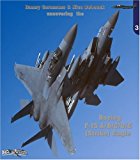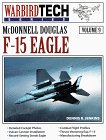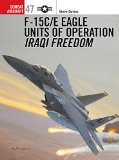The F-15 Eagle is a twin-engine, high-performance, all-weather air superiority fighter. First flown on July 27, 1972, the Eagle began entering the USAF inventory on November 14, 1974.
The F-15 was the first U.S. fighter to have engine thrust greater than the normal weight of the aircraft, allowing it to accelerate while in a vertical climb. This, combined with low aircraft weight compared to wing area, made the Eagle highly maneuverable.
The F-15 Eagle has been produced in single-seat and two-seat versions.
During Operation Desert Storm F-15C’s conducted counter-air operations over Iraq. They escorted strike aircraft over long distances and scored 34 aerial victories during the conflict. The F-15C was also used to search out and attack “Scud” ballistic missile launchers.
In the mid-1970’s the F-15 was adapted for use in the air-to-ground role. Capable of carrying about 7 tons of bombs, it became potent strike aircraft.
F-15B
The F-15B was a two-seat trainer model of the F-15 Eagle.
F-15C
The F-15C was an updated version of the F-15A. Major improvements include 2,000 lbs. of additional internal fuel capacity, provisions for Fuel And Sensor Tactical (FAST) Pack conformal external fuel tanks with weapons mount points for AIM-7 Sparrow missiles, and significantly improved avionics and radar. The addition of a programmable signal processor for the radar enabled easier updates of the system to meet changing combat conditions.
The first flight of the -C model was 27 February 1979 with initial deliveries starting later that year.
F-15D
The F-15D, a combat-capable two-seat trainer version, first flew on 19 June 1979.
F-15E Strike Eagle
The F-15E Strike Eagle was developed from an F-15B as a dual role fighter designed for both air superiority and air-to-ground missions. Unlike the F-15A and F-15C single-place aircraft, the F15-E model carries a pilot and a weapon systems officer (WSO).
The Strike Eagle, which first flew on 11 December 1986, was used extensively in the Persian Gulf during Operation Desert Shield/Storm with great success.
F-15 Eagle Performance
| Maximum Speed | Over 1,600 mph/1,390 knots (Mach 2.5) at 45,000 ft. |
|---|---|
| Range | 3,450 statute miles/2,998 nautical miles with external fuel tanks (F-15A) 2,500 statute miles with external fuel tanks. (F-15C) 2,762 statute miles with external fuel tanks. (F-15E) |
| Service Ceiling | 65,000 ft. |
F-15 Eagle Specifications
| Country of Origin | USA. |
|---|---|
| Similar Aircraft | F-14 Tomcat, Su-24 Fencer, Tornado, MiG-29 Fulcrum, Su-27 Flanker. |
| Crew | One (F-15A, F-15C) Two (F-15B, F,15D, F-15E) |
| Role | Air superiority fighter, interceptor. |
| Armament | One 20mm M-61A1 Vulcan cannon, AIM-7 Sparrow or AIM-120 AMRAAM missile, and AIM-9 Sidewinder missiles, plus 15,000 lbs. mixed ordnance carried externally. |
| Engines | Two Pratt & Whitney F100-PW-100 turbofans of 25,000 lbs. thrust each. (F-15, F-15A, F-15C) Two Pratt & Whitney F100-PW-220 turbofans of 23,450 lbs. static sea level thrust each with afterburner. (F-15E) |
| Span | 42 ft. 9 3/4 in. |
| Length | 63 ft. 9 in. |
| Height | 18 ft. 5 1/2 in. |
| Weight | 56,000 lbs. max. (F-15, F-15A) 68,000 lbs. max. (F-15C) 81,000 lbs. max. takeoff (F-15E) |
F-15 Eagle WEFT Description
| Wings | High-mounted, semidelta with angular, blunt tips. |
|---|---|
| Engine(s) | Two mounted in the rear. Diagonally-shaped, box-like air intakes alongside the fuselage. Dual exhausts. |
| Fuselage | Long, pointed nose and a bubble canopy. Large, box-like center section that tapers slightly to the front and rear. |
| Tail | Two fins with tapered leading edges, straight trailing edges, and square tips. Flats mid-mounted on the fuselage, swept-back, and tapered with angular, blunt tips, and a large sawtooth in the leading edges. |
Countries which Fly the F-15 Eagle
Israel, Japan, Saudi Arabia, United States of America.
Additional Reading on the F-15 Eagle
F-15 Eagle
Design notes on the F-15 Eagle
F-15 Eagle
The most effective western interceptor aircraft
F-15 Eagle
USAF Fact Sheet on the F-15 Eagle
F-15 Eagle Manufacturer Web Site
The F-15 Eagle was originally manufactured by McDonnell Douglas.
In 1997, McDonnell Douglas became part of Boeing.
Books on the F-15 Eagle

Boeing F-15 A/B/C/D/E (Strike) Eagle

McDonnell Douglas F-15 Eagle
Without a doubt the finest air fighter in service with western air forces, the F-15, still in production (now under the Boeing name) is meeting export orders for Israel and Saudi Arabia with interdictor variants. Includes in-depth coverage of systems, engines, weapons, development usage, and all 20 test aircraft. For military and aviation enthusiasts and pilots.

F-15C/E Eagle Units in Operation Iraqi Freedom
The F-15C/E has formed the backbone of US and Coalition operations in the Middle East for over a decade, patrolling the skies over northern and southern Iraq as part of Operations Northern Watch and Southern Watch. F-15C’s policed the skies for Iraqi aircraft operating in contravention of no-fly zone agreements, whilst the F-15E was constantly dropping weapons onto the Iraqi SAM and AAA emplacements that engaged Coalition aircraft undertaking this mission. The USAF’s use of the F-15 in the region culminated with Operation Iraqi Freedom, which was launched in mid March 2003 in order to liberate the people of Iraq and ensure the destruction of Saddam Hussein’s alleged weapons of mass destruction. In doing so, the F-15C was used to protect friendly troops and aircraft from any last-ditch attempt to use the Iraqi Air Force. In the event, the F-15Es of the 4th Fighter Wing saw most prolific use, engaging Iraqi armor before Coalition ground troops moved forward, and providing close air support to soldiers and Special Forces as they came into contact with the enemy.

USAF F-15 Eagles: Units, Colors and Markings
After twenty-five years of service with the USAF, the F-15 is still the most effective air superiority fighter in the world today. In addition, the F-15E Strike Eagle has taken over the F-111’s role as the USAF’s Strike Fighter. This book chronicles, with over 750 color photos, the story of the F-15A, B, C, D, and E. The book includes F-15 program history, prototype and operational aircraft paint schemes, and unit markings of all USAF and Air National Guard units operating the F-15. A section on USAF F-15 MiG killers in both Operation Desert Storm and Operation Allied Force, with photos of all USAF F-15 MiG killers, is included. Over 130 colorful official and unofficial unit patches involving the F-15 are included. The book also includes a description of the aircraft, its systems, and weapons.

Supporting Expeditionary Aerospace Forces: An Analysis of F-15 Avionics Options
The goal of the Expeditionary Aerospace Force (EAF) concept is to rely on rapidly deployable, immediately employable, highly effective and flexible air and space packages to flexibly serve the strategic role that a permanent forward presence formerly played in deterring and quickly responding to aggression. Building on earlier analyses that framed a range of general EAF support concepts, this report assesses how well alternative logisticsprocesses and organizational designs for meeting F-15 avionics maintenance demands across the spectrum of EAF operations support this concept. The alternatives range from the current decentralized organization associated with the policy of deploying intermediate-maintenance capabilities with the flying units to consolidated, nondeployingstructures. The authors find that consolidating F-15 avionics intermediate maintenance and supporting operations from regional support bases would be more conducive to achieving the EAF goal than the current structure, offering the potential to quickly respond to rapidly changing situations, reduce deployment airlift requirements, and ease the stress thatfrequent and unpredictable deployments place on maintenance personnel. These benefits would come at the expense of greater reliance on intratheater distribution.
